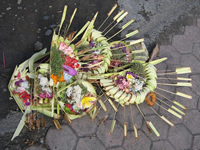Understanding Balinese Hinduism
 Visitors to Bali will be immediately aware of the strength of the local culture and its Hindu based religion. Flower offerings mark shop fronts, the rattle of gamelan practice can be heard on major streets and abundant family temples offer a clue that something other that just cash and capitalism is at work here.
Visitors to Bali will be immediately aware of the strength of the local culture and its Hindu based religion. Flower offerings mark shop fronts, the rattle of gamelan practice can be heard on major streets and abundant family temples offer a clue that something other that just cash and capitalism is at work here.
Reading about the beginnings of the modern era Balinese Agama Hindu, my book (The Natural
Guide To Bali ) says the following. ‘The Shiva-Buddha tradition brought the Hindu cosmic framework, in which the world is a living totality uniting spiritual and material elements in an unending process of transformation. Beyond its many manifestations, the Oneness of God is the merging of spirit / masculine and matter / feminine principles, uniting the 3 forces of creation (Brahma), balance, (Wisnu) and destruction (Shiva). Man is subject to a similar process or integration and transformation; the ‘samsara’ or transmigration of the soul. Incarnation binds the soul to the body, and is seen as a hellish condition, which one should strive to overcome by achieving ‘moksa’ or ultimate enlightenment – then the soul and body may rejoin their cosmic equivalent.’
Pretty intense stuff which takes some explaining. Bali’s connection with India goes back to the 1st century AD, when Indian traders began visiting the island. The Hindu religion did not take hold in Bali until the 9th century as witnessed by the Sanskrit inscriptions at places such as Prasasti Blanjong in Sanur. Buddhism preceeded Hinduism in Bali, but it was the latter that eventually became dominant. Hinduism strongly took hold in Java, with the local indigenous beliefs being fused with the exotic import. By the 13th century, Hinduism in Bali was a amalgam of Hinduism, Balinese and Javanese indigenous systems. This process was accelerated further by the Majapahit empire in Java, which conquered Bali in 1343, which brought the Javanese version of the religion into the island, complete with its blending of Shivaite and Buddhist elements.
Local Balinese adapted to the new religious input by combining it with their old belief system. The fertility cults that date back to megalithic times became Shiva linggam cults, example of which is at Goa Gajah temple SE of Ubud.
The high caste Majapahit newcomers set themselves up in population centers were they could
extend their power. The reach of the new version of Hinduism was strongest in these places. The Bali Aga (original Balinese), who still live in the central highlands and such places as Tenganan and Trunyan, did not want anything to do with the newcomers, shunning their exotic beliefs. The Bali Aga and their system is only partially connected to the Shiva-Buddha belief system.
The Hindu caste system was a major import from Java, the Majapahit noblemen wanting to maintain their status. Most of the Balinese were labeled as Sudra (commoner), the 3 higher castes (Brahmana, Satria, Wesia) being reserved for the priests, warriors and traders from Java. Interestingly Sudra also means ‘outsider’, the inference that the Balinese locals were outside the court. Balinese people already had their own social hierachy, a kinship system called ‘warga‘ (family clan). The palaces (puri) and priestly houses (gria) were places where the Shiva-Buddha aspect of Balinese Hinduism was centered. The local rajas keeping with the Balinese agrarian system and combining it.
The fascinating thing about all this is the gradual acquisition of a developed higher level religion into a region. As it starts to get accepted it absorbs elements of the local mythology (Javanese) and then moves again, only to be re-combined with a local Balinese mythology.